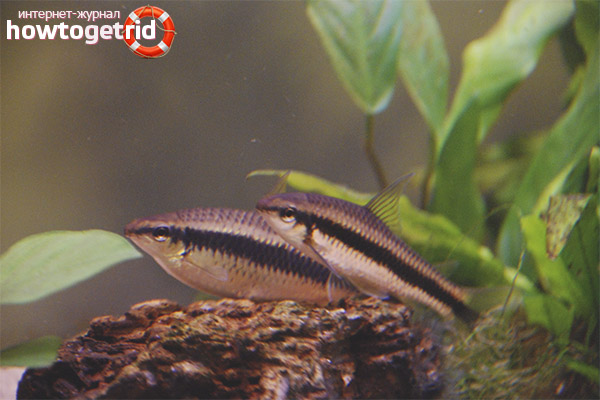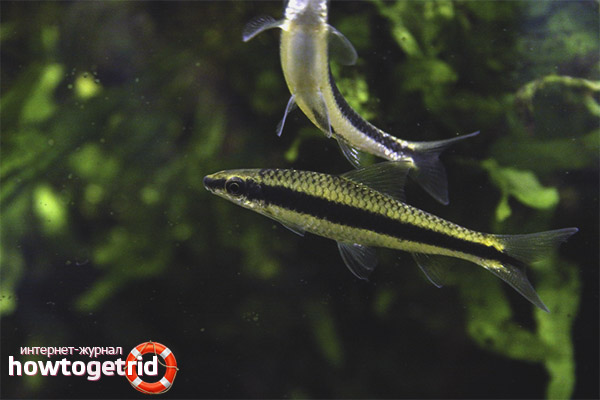The content of the article
Siamese seaweed is understood as an insatiable and medium-sized aquarium cleaner. In addition to these representatives, there is also a Siamese radiant chanterelle (false algae). Many people, especially inexperienced aquarists, confuse representatives of this family. In fact, there are certain aspects that will help to distinguish the algae from similar individuals. Let's analyze all the details, as well as touch on the requirements for maintenance and care.
Important information
If to judge in general, then the Siamese algae, sold in the store, are mostly authentic. However, unscrupulous or inexperienced aquarists sell false Siamese representatives to the present. Then there are difficulties with the choice, but these fish differ from each other.
First, the true representatives of this family have a black stripe,which stretches along the body and always continues on the tail. As for false fish, they have a tail fin without a strip.
Secondly, if you are in front of a genuine Siamese algae, then his line will go zigzag with jagged edges.
Third, false breed representatives have an oral cavity resembling a pink ring.
Fourthly, in authentic fish there is one pair of whiskers, which is barely noticeable, black. As for false representatives, they have 2 pairs of whiskers.
Naturally, the question is brewing - what is the difference and why choose a genuine representative of the family? False fish is aggressive, practically does not eat algae, has a different temperament and peculiarities of care. While Siamese algae are relatively peaceful, suitable for keeping in a large and populated aquarium.
It is difficult to determine for sure what sex an individual is in front of you. It is assumed that females have a more rounded abdominal region, and males are shot down.
Habitat
Dwells in Thailand, Indonesia, Asia. It prefers streams and fast flowing rivers, which have a dense and solid bottom.It is desirable that the aquarium environment was similar to a biotope, that is, it would concentrate gravel with sand at the bottom, as well as cobblestones, roots and driftwood. Since the presented fish feed on algae, they require clear water with thickets. Then algae will feel good and multiply. At certain times of the year, these fish migrate and migrate to turbid water sources with sufficient depth.
Content
- Fish grow to 12-15 cm with an average life expectancy of 10 years. It is necessary to keep the inhabitants in a simple aquatic environment. A couple of individuals relies 100-200 l. water. Siamese fish get used to the changes of water, so the difficulties with care will not arise.
- The best option for keeping is considered to be imitation of the environment in which fish live in nature. As a litter, choose a soil consisting of sand and pebbles. Install snags, locks of clay, various grottoes. With all this, it is necessary to provide enough space for swimming and plant plants with wide foliage.
- Fish contain at a temperature of 23-26 degrees. Particular attention is paid to acid-base medium, which should not go beyond the boundaries of 5.5-7.5 pH.Stiffness required 5-20 units.
- The fish is in nature jumping, so it is necessary to cover the aquarium with a glass lid. As a similar option, send floating plants to the aquarium to cover the surface of the water.
- If you provide the algae a balanced diet, the fish will not destroy vegetation. But if in the diet there are no dietary fibers and fiber in particular, then the Siamese will begin to eat duckweed, moss, hyacinth.
- With regard to breeding, seaweed are those types of fish that do not breed under aquarium conditions. Those specimens sold in the store were grown on farms or were caught in their natural habitat. Therefore, there is no reliable information on how to spawn.
Feeding
- Representatives are considered to be herbivores. In the wild, such fish feed exclusively on phytoplankton and algae. Therefore, in conditions of keeping in an aquarium, the represented individuals should be fed with similar products.
- Often, manufacturers offer food that is presented in granules or flakes. In addition, the fish can be further fed with greens and vegetables. They eat zucchini, cucumbers, spinach, dandelions, apples and blanched peas.
- Such products are finely chopped and doused with boiling water. It is recommended to boil peas and zucchini in advance. An additional source of food or algae that can grow on snags or stones in an aquarium can be used as a treat.
- Some representatives of the species can eat the leaves of other plants. It does not have to be algae. If you do not want to constantly suffer from vegetation in the aquarium, it is recommended that you thoroughly approach the arrangement of the home for fish. Siamese can eat plants only at a young age. Over time, this passes.
- If you provide proper and balanced nutrition for algae, they will not conflict with other inhabitants of the aquarium. If the specimens in question lack the dietary fiber found in vegetables, the fish will begin to damage the plants.
- Often these algae are not intended to be eaten.Among ornamental plants for the aquarium can be distinguished duckweed, Javanese and Christmas moss, water hyacinth.
Compatibility
- Siamese are different from most fish calm character. Therefore, such individuals can be easily maintained with non-aggressive representatives of the water world. The only condition is that the neighbors need to be hooked in a similar size.
- When living a flock of Siamese in the aquarium, there is always a stronger individual who is the leader. Keep in mind, in one family must contain at least 8 fish. If individuals contain in smaller quantities, then stronger relatives will offend the weak representative of the species.
- Such fish get along well with scalars, flocks of Sumatran barbs and gyrinoheyluses. Consider that in one aquarium it is recommended to contain no more than 2-3 algae males. The problem is that such individuals will constantly fight for leadership.
- Siamese are small fish, but their size and excessive activity do not interfere with playing with larger individuals, such as cichlids. Consider as this increases the riskthat during the conflict one of the individuals may suffer. That is why Siamese is recommended to keep in a separate aquarium.
It is important to know that the fish in question do not breed in captivity. The successful breeding of algae-eaters in an aquarium has never been recorded. To make the fish feel as comfortable as possible, it is necessary to ensure proper living conditions for the Siamese. Also take care of high-quality and balanced nutrition.
Video: Siamese Algae Eater













To send